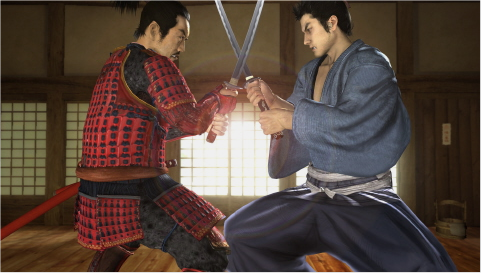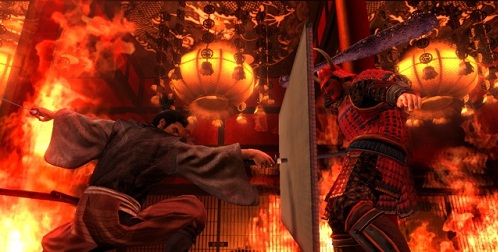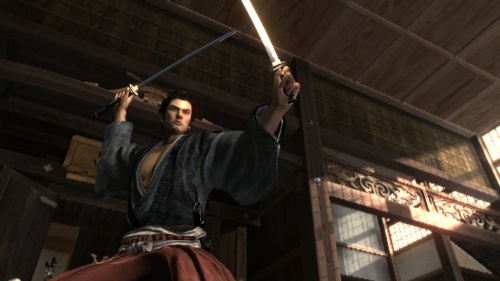No retro review this week, as all this talk of Binary Domain reminded me that I had completely forgotten to review this way back when, and with Yakuza 4, Of the End and Binary Domain all on the way, it seemed like as good at time as any to pull it out. Kenzan is very close to being the best in the series, and at the very least its so far my favourite of the bunch. And maybe, just maybe, telling you why might excuse the fact that I haven’t finished Policenauts.
Kenzan kicks off incredibly curiously. You do play Kazuma (Kazumanosuke Kiryuu this time around), however that’s only an assumed name. His real name for the purposes of Kenzan’s story is that of legendary swordsman Miyamoto Musashi. The rest of the cast are just as confusingly famous characters from the Yakuza series taking on brand new fictional and historical roles, including Majima Gorou coming back as another rather unsettling but helpful companion. Another more disturbing return is made by Haruka, Kazuma’s adopted adopted-step daughter.
Their meeting this time around is when Haruka arrives at Kazuma’s jack-of-all-trades style shop, wanting the murder of the man responsible for killing her family. Unfortunately, she names Miyamoto Musashi (Kazuma’s actual identity) as the killer, which raises a few issues. Kazuma replies that she has no money to pay him, which causes her to approach a passing madam in order to become a ‘kamuro’, which is effectively a child apprentice at a brothel. She sells her body to the sex trade, in turn earning the money it’ll cost for Kazuma to hunt down her family’s murderer.
This is an incredible premise for any game, especially so in comparison to Yakuza 3’s incredibly slow start at the orphanage. Already we understand the massive predicament that Kazuma has found himself in during barely even the first hour of the game. Haruka again having her family taken away and having to sell her body to get closure really grabbed me as the player, and became a strong enough motive to see things through to the end.
You still have to wait quite a while to do so, as she only returns some chapters later with the required money to hire Kazuma, but in the meantime you get some great back story about Kazuma’s life as Musashi. Not only that, but introducing the predicament before jumping into the role of Musashi adds some fascinating tension to the whole affair, as you’re on the look out to see just when or how Musashi’s dagger ends up in Haruka’s possession leading her to accuse him in the first place.
I really adore the story, but of course the game is unfortunately entirely in Japanese at the moment, and if you ever want to play through the whole thing yourself the only advice I have is to follow this FAQ as much as possible, as in the course of playing through it I had it open in no less than SEVEN browser tabs, each pointing at a different section. The story and atmosphere is incredibly rich, but also nigh impenetrable for a purely English audience. The funny thing is that this is actually what I loved most about this entry, that it’s so culturally different from what I’m used to, which is also the reason cited by Sega for not publishing this particular one overseas.
General progression is exactly the same as the other Yakuza games. Once things get rolling, you’re free to indulge in a lot of extra activities and side-quests, as well as the revelations that would eventually make their way into Yakuza 3. You visit a painter who gives you ideas about what to create a move out of, and then you go off to view some ridiculous sight which inspires you to create a new technique. These are always incredibly worth checking out as this is where most of your weapon-based HEAT actions will come from.
The focus of combat in Kenzan is actually in using weapons rather than just your fists. You have access to a single sword stance, a dual sword stance and a heavy sword stance, each of which requires a different weapon equipped to affect damage output. You can actually visit a blacksmith to have them tempered and upgraded, and there’s a lot of joy to be had in slowly building your weapons into more and more powerful tools. This also encourages you to seek out all the optional side quests, as they can often reward you with the rare materials needed to create an especially powerful new weapon.
This does mean there’s a little less room for the improvisation that makes combat in regular Yakuza so fun, but the fact that everyone around you is wielding a sword or spear does tend to suit a more planned form of attack. You have regular combo attacks, but you can also charge up your heat bar by holding a strike after you’ve performed it. This means you have to alter the flow of combat yourself to ensure that you’re always defending yourself while at the same time making sure you can power up your most impressive techniques in order to either kill one enemy outright or cut through a whole swathe of them. There’s no shortage of blood letting in this one, and every sword stroke leaves its bloody mark on both enemy and scenery. It’s slower paced than the usual Yakuza melee, but it’s all the better for it.
Some of the side-quests tie into this, as there are bounties for taking out certain tough foes non-lethally, so using your sword or your fists has a very real consequence in certain encounters. What’s really fun is how they worked extra weapons into the side quests as rewards, for instance there’s a very long one concerning enchanted swords, one of which is wielded by an angry drunk. As it turns out, it actually is a sword that gets stronger the more drunk you are, and even in the often unforgiving world of Kenzan the trademark bizarre humour of the series still manages to shine through without breaking the rather serious atmosphere. One of my favourite parts of the game is a waterfall where Kazuma can meditate under to boost his stats, but in doing so he has to battle a kind of lust demon that tries to break his concentration in a special mini-game. So, while in the real world it appears that he’s in an incredible disciplined state of training, in actuality his meditation involves not losing self control in front of increasingly gorgeous visions of women.
It should also be mentioned how damn pretty the game looks, especially since it came before Yakuza 3, and the series hasn’t before or since tried to picture a world that’s quite as fertile or rural as parts of Kenzan’s are depicted. Waltzing down the streets of Gion in Kyoto feels nothing like the cold and familiar modern city we’re used to. Instead it’s filled with cherry blossoms and brothels, with masses of people flocking down busy main streets. The unique setting makes the whole experience feel like a well constructed playable version of any classic jidaigeki movie, with that great Yakuza balance of a strong and compelling main story and cast with really satisfying combat and enjoyable diversions.
However the way it takes the familiar Yakuza staples and applies them to this nostalgic setting is really what sells the experience. You can play classic tabletop games like Hanafuda and Shogi, and even baseball is instead a form of swordsmanship training as massive fruit is lobbed at you at great velocity and the goal is to cleanly slice them in two. If anything could be improved upon, besides the slightly stilted exploration controls of all Yakuza games, is that you still don’t have that much in the way of exploration. There’s an awful lot to do, true, but you never get the ability to just explore a vast nothingness at any point. It would’ve been really nice to have mounted a horse and taken off in search of maybe one of the bounties or some other diversion like a kidnapping, especially since there is actually a training area for riding a horse and dodging obstacles while precisely hitting targets with a bow and arrow. It’s a great diversion, but it also could’ve been more interestingly woven into the rest of the narrative or the competent bounty system.
Overall, it’s the originality of Kenzan that really sold the experience to me and made it my favourite of the collection. Yakuza 3 is still the one I’d recommend to people not just because Kenzan still doesn’t having a damned localisation, but because also Yakuza 3 demonstrates really well what’s great about the series. Kenzan on its own would be great, but standing parallel to Yakuza really emphasises the strengths of both of them, and that the attachment you have to the characters extends between the two games despite hundreds of years difference in historical context truly exemplifies the real strengths of the series and of the Yakuza development staff.
Like a dragon, Ryu Ga Gotoku Kenzan! is something most gamers will be unlikely to ever see first hand. A- (Half a mark deduction for the crushing disappointment of reality)





Very good review, Alex.
Kenzan! sounds even better than I expected and my expectations weren’t low ones, oh no sir.
If Sega only, in a crazy-miraculous moment, decided to make the game available (with english subs) at least via DLC.
Reality always hurts…